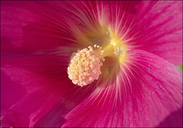|
|
click photo for larger file

Alcea rosea
Common Hollyhock
|
Photographer: Dr. Amadej Trnkoczy
ID: 0000 0000 0525 0064 (2025-05-03)Copyright © 2025 Dr. Amadej Trnkoczy
|
|
INFORMATION PROVIDED WITH THE PHOTO
|
date of photo Jun 24, 2010
latitude 44.37540 longitude 14.78110
View on Google Maps.
location
Zadar archipelago, island Olib, Olib village, south of the parish church. (Zadar region, Croatia)family
Malvaceae
notes Slo.: rožlin, slezova vrtnica - syn.: Althaea rosea (L.) Cav., Alcea ficifolia L., Althaea ficifolia (L.) Cav.. - Habitat: On the edge of an abandoned garden; also outside it between the gravel path and the garden wall, ruderal ground, once cultivated or escaped from cultivation; flat terrain, open, mostly sunny, dry location; elevation 17 m (55 feet), average precipitations ~ 950 mm/year, average temperature 13-15 deg C, Mediterranean phytogeographical region. - Substratum: sandy soil. - Comment on Flick album Alcea rosea: Today, the most well-known forms of Alcea rosea are hybrids and other cultivated taxa in horticulture. Plants blooming in various colors are available on the market, ranging from small varieties to those 2.5 m tall. Interestingly, its native range seems small and uncertain. EURO+MED (Ref.: ) identifies it as covering a small area on the western Balkan Peninsula, in present-day Montenegro. However, POWO (Ref.: ) states Turkey as its native range. In both cases, it is a small region compared to today's distribution range. Due to its stature, showy appearance, large, brightly colored flowers, and a long bloom period from June to August, the plant gained popularity in horticulture long ago. It is now cultivated in gardens worldwide. Often, it escapes gardens and grows, at least temporarily, sub-spontaneously in the wild; however, it is still almost always found near human settlements. - The flowers of Alcea rosea are ecologically important for a variety of pollinators. They are crucial for at least four species of wild bees, as the nectar from this taxon is essential for their survival. Additionally, the plant is considered medicinal and is used in some countries as an antitussive (quiet cough by blocking the cough reflex); however, it is generally regarded as poisonous. - Ref.: (1) T. Nikolić, Flora Croatica, Vaskularna flora Republike Hrvatske, Vol. 3. Alfa d.d.. Zagreb (2020), p 158. (2) A. Martinči et all., Mala Flora Slovenije (Flora of Slovenia - Key) (in Slovenian), Tehnična Založba Slovenije (2007), p 473. (3) (x) M. Blamey, C. Grey-Wilson, Wild Flowers of the Mediterranean, A & C Black, London (2005), p 133. (4) Euro+Med (2006+), Euro+Med PlantBase - the information resource for Euro-Mediterranean plant diversity. http://www.europlusmed.org [accessed DATE] (5) POWO (2024). 'Plants of the World Online. Facilitated by the Royal Botanic Gardens, Kew. http://www.plantsoftheworldonline.org/ (accessed xx xx xxxx)camera Canon G11, 6.1-30mm/f2.8-4.5
contributor's ID # Bot_0431/2010_IMG1138 photo category: Plant - annual/perennial
|
MORE INFORMATION ABOUT THIS PLANT
|
| common names
Common Hollyhock (photographer)
View all photos in CalPhotos of Alcea rosea Check Google Images for Alcea rosea |
|
The photographer's identification Alcea rosea has not been reviewed. Sign in to review or comment on this photo |
|
Using this photo The thumbnail photo (128x192 pixels) on this page may be freely used for personal or academic purposes without prior permission under the Fair Use provisions of US copyright law as long as the photo is clearly credited with © 2025 Dr. Amadej Trnkoczy.
For other uses, or if you have questions, contact Dr. Amadej Trnkoczy amadej.trnkoczy[AT]siol.net. (Replace the [AT] with the @ symbol before sending an email.) |
|
|
